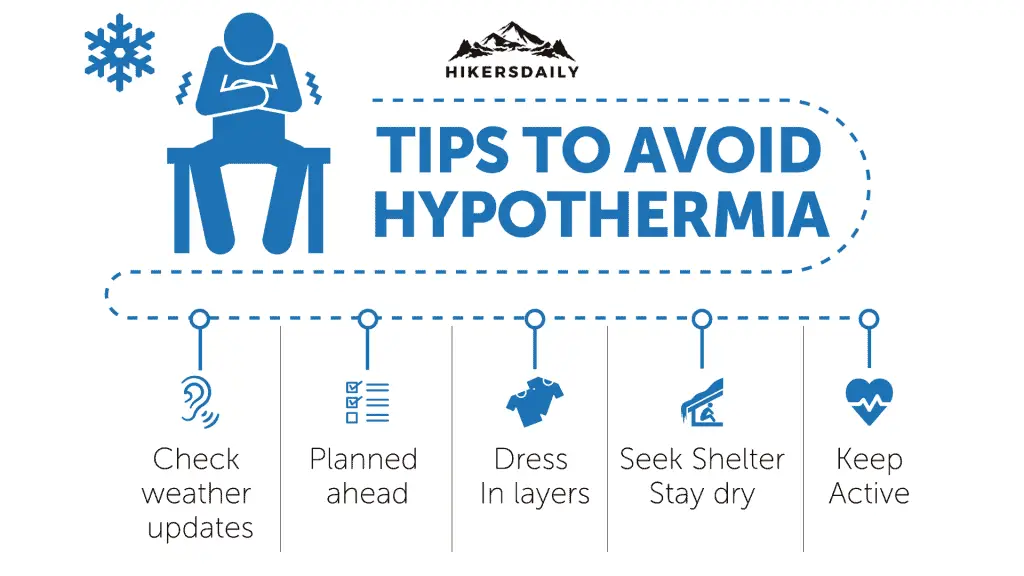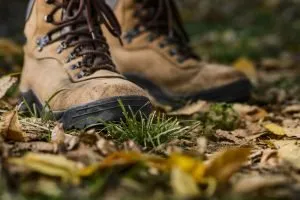10 Best Safety Tips For Hiking In The Rain

Some people like the sound of rumbling thunder and the smell of rain. Others like living it.
Hiking in the rain can be an exhilarating, albeit dangerous, experience. Learning how to hike safely in the rain is essential for any adventurer. And besides, you never know when a rainstorm might show up while you’re miles away from home.
So in this blog post, I’m going to share some of my best tips, wet-weather hiking gear recommendations, and techniques for staying safe on a wet and wild hike.
Quick Links
10 Safety Tips For Hiking In The Rain
1. Check The Weather Report
This might seem like an obvious one, but it’s crucial. You need to know what to expect weather-wise before heading out into the wilderness.
And there are apps and websites that focus specifically on providing accurate weather information for hikers and outdoor enthusiasts, such as Mountain Forecast. Mountain Forecast is pretty awesome – they break things down by elevation so you can get a more precise idea of what the conditions will be like where you’ll be hiking.
2. Don’t Hike Alone
Hiking alone can be dangerous at the best of times, but it’s even more so in bad weather. So if possible, hike with a friend or two.
Not only will it be more fun, but you’ll also have someone to help you if things go wrong.
3. Tell Someone Where You’re Going
This is related to the previous point. It’s always a good idea to let someone know where you’re going and when you expect to be back.
That way, if you don’t return when you’re supposed to, they can notify the authorities and start a search.
4- Bring a Personal Locator Beacon
A Personal Locator Beacon (PLB) is a small, handheld device that sends out a distress signal if you activate it.
This can be incredibly useful if you get lost or injured while hiking and need to be rescued. If things take a turn for the worse, a PLB could literally be a lifesaver.
5. Stay on the Trail
This one is pretty self-explanatory, but it’s worth repeating. Once the trail becomes wet and slippery, it can be very easy to lose your footing and take a tumble.
So stay on the beaten path as much as possible, and be extra careful when crossing streams or other bodies of water.
6. Wear the Right Clothing
Wearing the right clothing is essential for staying comfortable and safe while hiking in the rain.
This doesn’t mean you’ll need a whole set of new gear, but there are a few key items that can make all the difference. Since this is a pretty big point of discussion, I’ll have an entire section dedicated to the right hiking gear for wet-weather hiking below.
7. Be Careful With Your Footing
To touch on number five again, it’s important to be extra careful with your footing when hiking in the rain.
Wet and slippery conditions can make even the most experienced hikers lose their footing from time to time. So take your time, watch your step, and don’t be afraid to backtrack if necessary. I would highly recommend a pair of solid trekking poles for hiking in the rain.
8. Don’t Cross Flooded Streams
If you come to a stream or river that’s been flooded by the rain, don’t try to cross it. The current will be too strong, and you could easily be swept away.
The best thing to do is find a safe place to wait it out until the water level drops. And if there’s no way around it, you can try to make a makeshift bridge out of logs or large rocks.
9. Beware of Lightning
This one is pretty self-explanatory, but it’s worth mentioning. If you hear thunder, that means lightning is close enough to strike. So seek shelter immediately and stay there until the storm passes.
As far as shelters go, caves and large boulders are your best bet. But if you can’t find anything like that, just make sure you’re not the tallest object around.
10. Be Prepared for the Worst
Not to sound grim – but it’s always a good idea to be prepared for the worst when hiking in the rain, or really anytime you’re hiking in the backcountry.
Make sure you have all the necessary gear, and that you know how to use it. And most importantly, make sure you have a solid plan for what to do if things go wrong.
This means bringing extra food, water, and clothing – just in case you get stranded overnight or have to hike out in bad weather.
The bottom line is this: bad weather can make even the simplest hike a dangerous proposition. So it’s always better to be safe than sorry, and it’s better to have too much than not enough.
What To Wear When Hiking In The Rain
Okay, let’s talk about clothing. This is probably the most important factor in staying comfortable and safe while hiking in wet weather, so it’s worth taking the time to get it right.
The first thing to keep in mind is that you’ll want to avoid cotton at all costs. Cotton absorbs moisture, which means it will make you feel wet and cold even if you’re not actually sweating.
Instead, you’ll want to opt for synthetic fabrics or wool. These materials will help wick away moisture and keep you feeling dry, even when you’re sweating.
As far as specific items go, here’s what I would recommend packing for a wet-weather hike:
- A Waterproof Jacket: This is an absolute must. Look for a jacket that’s both waterproof and breathable. And make sure it has a hood, since rain can come at you from all angles. Check out this lightweight waterproof rain jacket from Marmot for a good idea of what to look for.
- Waterproof Pants: Again, you’ll want something that’s both waterproof and breathable. Gore-Tex is a pretty good choice here – but there are plenty of other good options to look out for.
- A Synthetic Base Layer: A long sleeve shirt and a pair of pants made from a synthetic fabric like polyester or wool will help wick away moisture and keep you feeling dry.
- Merino Wool Socks: These are my personal favorite, but there are plenty of other options out there. Just make sure they’re made from wool or another synthetic fabric.
- Waterproof Hiking boots: A good pair of hiking boots will go a long way towards keeping your feet dry and comfortable. But, and this is very important, look for WATER-PROOF hiking boots, not WATER-RESISTANT. There is a big difference.
- Gaiters: Gaiters are an absolute must for hiking in the rain. They’re a great way to keep your legs dry and prevent water from getting into your boots. If you don’t know what they are, check out these gaiters from the Pike Trail Store. Most gaiters are pretty affordable, so you don’t have to break the bank to get a pair.
- A Rain Hat: A hat will help keep the rain out of your eyes, and it will also protect your head from the cold. A bandana or a baseball cap will work in a pinch, but a dedicated rain hat is always best.
- Trekking Poles: Trekking poles are optional, but they can be a big help when hiking in the rain. They’ll take some of the strain off your legs, and they’ll also help you keep your balance on wet and slippery trails. I like the Cascade Mountain Tech Trekking Poles. If you are looking for more budget options, check out my guide on the best budget trekking poles of 2022.
- Extra Dry Clothes: Finally, make sure you bring along an extra set of dry clothes. This way, you can change into something dry if you get soaked through.
- Waterproof Backpack: A waterproof backpack is a good idea, but it’s not strictly necessary. If you don’t have one, you can use a waterproofing spray or a waterproof pack liner.
I know it may seem like a lot, but a lot of this stuff is used for hiking in dry weather as well. Most of the gear you buy or own for hiking should already be somewhat waterproof as well. Really, the main differences here are rain jackets, waterproof pants, gaiters, and a waterproof backpack (or waterproof pack liner.)
Why Hike in The Rain?
Now that we’ve gone over some of the dangers and safety tips of hiking in the rain, you might be wondering why anyone would do it in the first place. Good question!
I mean, wouldn’t it just be easier to wait for a sunny day?
Well, there are actually a few pretty good reasons to hike in wet weather. For starters, the trails will be less crowded.
If you’re looking for a peaceful hike where you can really take in the scenery, wet weather is the perfect time to do it. For the most part, it’ll be you, the rain, and the trail. Your mind will be able to wander, and you’ll be able to really take in your surroundings.
Another reason to hike in the rain is that it can actually be pretty fun. I know that sounds crazy, but hear me out. There’s something about being out in the elements that just feels good. Being out in nature, surrounded by the sound of the rain, that’s strangely calming. And as I said, some people like to listen to the sound of rain, others like to feel the rain on their skin.
And finally, wet weather hikes can be incredibly rewarding. When you finally make it to the top of the trail, and the sun comes out from behind the clouds, the view will be that much more beautiful.
So if you’re up for a challenge, or just looking for a different way to experience the great outdoors, wet-weather hiking is definitely worth considering.
Will I Get Hypothermia If I Hike In The Rain?
Hypothermia is a real concern when hiking in cold, wet weather. But as long as you take the proper precautions, it’s actually not that difficult to avoid. The first thing you need to do is dress properly. We’ve already gone over what to wear when hiking in the rain, but it’s worth repeating:
Opt for synthetic or wool fabrics as opposed to cotton, and make sure your clothes are waterproof. A good rule of thumb is to dress in layers (even during the summer). That way, you can take off or add layers as the temperature changes throughout your hike.
Another thing to keep in mind is that you’ll need to stay hydrated. This is important anytime you’re hiking, but it’s even more important when it’s cold and wet. Just because the sun isn’t beaming down on you, doesn’t mean you’re not sweating. It actually becomes a bigger problem when hiking in the rain or in colder weather, because you might not even realize you’re sweating or getting dehydrated.
So make sure you’re drinking plenty of water, even if you don’t feel thirsty. And definitely stay away from drinks that can dehydrate you, such as coffee and alcohol. (I know – no fun.)

Signs of Hypothermia
Let’s go a bit further and talk about what hypothermia actually is, and how to spot the signs.
Hypothermia happens when your body temperature drops below 95 degrees Fahrenheit. It’s a serious condition that can lead to death if not treated properly.
Some of the early signs of hypothermia are:
- Shivering
- Feeling cold
- Numbness in extremities
- Exhaustion
- Confusion
According to Mayo Clinic, people with hypothermia may not even know they have it. Hypothermia can sneak up on you very gradually, so it’s important to know some of these symptoms & signs.
This is why it’s so important to dress for success when it comes to wet-weather hiking. If you can keep your body temperature from dropping in the first place, you’ll be much less likely to develop hypothermia.
Conclusion
Wet weather hiking can be a great way to avoid the crowds, have some fun, and see some incredible views from a new perspective. But it’s important to take the proper precautions, such as dressing appropriately and staying hydrated.
Now that you know what to expect, go ahead and give it a try! And if you have any tips for wet weather hiking, feel free to share them in the comments below.







